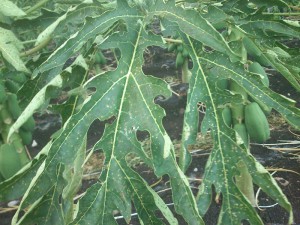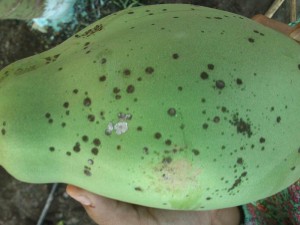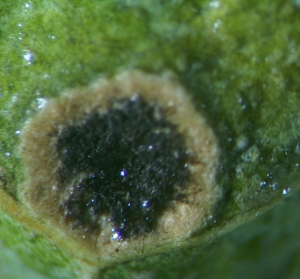Asperisporium Caricae
Black spot of Papaya / Asperisporium Caricae.
The black spot of papaya is caused by the fungus Asperisporium Caricae , this disease is widely distributed in many countries, among which is Mexico.
Symptom.
The symptoms that can commonly be observed are irregular spots mainly on the oldest leaves from which the pathogen spreads to the new ones. The spots on the top of the leaf are dry white beige lesions. However, the typical symptoms are shown on the underside or the bottom of the leaf which shows black spots, from which the name of the disease derives.
Fruits can also be affected although they commonly show less spots than foliage.
Black spots in both foliage and fruit are composed of a mass of black spores (figure 4), which are bicellular.
This disease is more common in areas with high relative humidity and average temperatures that are between 18 and 25 ° C. In the States of Jalisco, Colima and Michoacán; It can be presented in the months of September – March.
- caricae control:
- Remove as far as possible the older leaves infested with the fungus in order to favor ventilation and reduce the risk of presence.
- Eliminate the affected fruits found in the tree and soil, as well as the weeds that can favor a favorable microclimate for the fungus.
Chemical control
Preventive:
- Application of Phosphorous Acid at a dose of 1.0 L / hectare in irrigation from the third month of the plant and 3 subsequent applications every 2 to 3 weeks, the application will be carried out in drip irrigation.
- Apply contact fungicides such as: Copper hydroxide 2 g / L water; Copper Oxychloride + Mancozeb 2 g / L, chlorothalonil 2 g or mL per liter of water.
Systemic:
Diphenoconazole at a dose of 350 to 500 mL per hectare.
Note: Applications must be made when the conditions indicated may be favorable for the fungus.
Copyright © All Rights Reserved.
Semillas del Caribe / One Step Ahead







